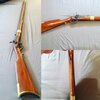From the many threads I’ve read concerning the .32 I’ve never seen anyone load beyond 30 grns, and many load well below that with as little as 10, and this for hunting small game.
What I see often recommended as a start is to load a volume comparable to the caliber rounded (30 grns in a .32 and 35 in a .36), though this was always in much larger calibers. Also it seems the slower twists tend to use heavier charges, though I’ve often seen it claimed (slower twists?) rifles often have 2 accurate loads, one light and one heavier (barrel harmonics?).
I’ve also seen it claimed often enough that a tighter fitting combo of ball/patch gets tighter groups, but that many prefer a load that’s easier to load for field use so as not to need a short starter or even mallet.
Once you are done with the powder you have I’d suggest you try Goex Olde Eynsford. It’s much more energetic and so may require less powder offsetting the slight cost difference (~$1.50/lb), but more to the point that it leaves less fouling by all accounts, which, from what I’ve read, can be a big deal in smaller calibers.
Another tid bit of info is if you find yourself lacking time to thoroughly clean your rifle(s) use a liberal amount of BP oil (I use Ballistol and love it as it will readily mix with water allowing it to evaporate leaving just the oil) which will neutralize it. I’ve tested this with my 2 revolvers leaving them for days in the Texas summer in high humidity and it worked like a charm (I was told this after leaving my rifle over night having shot Pyrodex which left a nasty rusty mess).
What I see often recommended as a start is to load a volume comparable to the caliber rounded (30 grns in a .32 and 35 in a .36), though this was always in much larger calibers. Also it seems the slower twists tend to use heavier charges, though I’ve often seen it claimed (slower twists?) rifles often have 2 accurate loads, one light and one heavier (barrel harmonics?).
I’ve also seen it claimed often enough that a tighter fitting combo of ball/patch gets tighter groups, but that many prefer a load that’s easier to load for field use so as not to need a short starter or even mallet.
Once you are done with the powder you have I’d suggest you try Goex Olde Eynsford. It’s much more energetic and so may require less powder offsetting the slight cost difference (~$1.50/lb), but more to the point that it leaves less fouling by all accounts, which, from what I’ve read, can be a big deal in smaller calibers.
Another tid bit of info is if you find yourself lacking time to thoroughly clean your rifle(s) use a liberal amount of BP oil (I use Ballistol and love it as it will readily mix with water allowing it to evaporate leaving just the oil) which will neutralize it. I’ve tested this with my 2 revolvers leaving them for days in the Texas summer in high humidity and it worked like a charm (I was told this after leaving my rifle over night having shot Pyrodex which left a nasty rusty mess).


